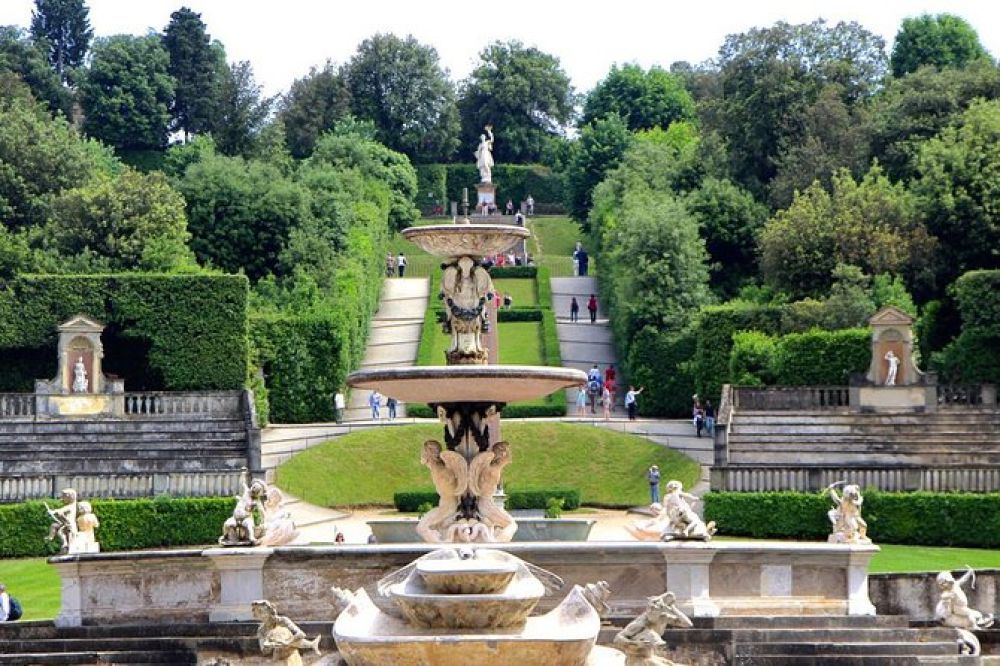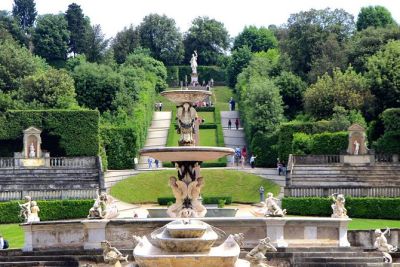

The Boboli Gardens, a magnificent example of Renaissance landscaping, provide visitors with a variety of stunning vistas and historical structures. One of the garden's focal points is the Amphitheater, which is located near the main entrance. Originally created as an open space for court ceremonies in the Medici era, it now serves as an exquisite example of outdoor architecture echoing the classical past. The space is encircled by classical statues and an Egyptian obelisk that adds an exotic touch to the Italianate setting. Strolling through the Amphitheater allows one to envision the grandeur of historical events and performances once held in this verdant space. Botanical enthusiasts and history buffs alike will appreciate the melding of meticulously designed nature with the echoes of Renaissance entertainment.
Deep within the Boboli Gardens lies the mystical Boboli Grotto, also known as 'Grotta Grande,' designed by renowned architects Bernardo Buontalenti and others. This remarkable space consists of three connecting chambers that house a fascinating array of Mannerist sculptures and wall embellishments resembling natural rock formations and dripping stalactites. Visitors entering this cool and semi-darkened space are mesmerized by its eerie yet enchanting atmosphere, transporting them from the warmth of Florence's sun to what feels like an underground fairy-tale world. Each chamber offers its unique set of decorative elements and sculptures, including copies of famous works like Michelangelo's 'Prisoners,' adding an artistic gravity to the already enchanting surroundings. The play of light, shadow, and water creates an unforgettable ambiance that has captivated visitors since the 16th century.
For the connoisseur of fine ceramics, the Porcelain Museum, housed in the Casino del Cavaliere high in the Boboli Gardens, is an unmissable experience. This museum boasts an exquisite collection of Italian and European porcelain, charting the evolution of this delicate art form. As you navigate through the small, yet richly arranged rooms, one can't help but be enchanted by the intricate designs and the stories they tell of opulence and sophistication. Each piece, whether it be from a Meissen dinner service or a Doccia statuette, showcases the exceptional craftsmanship that has long been associated with noble European life. Gaze upon tableware once used by grand dukes and duchesses, and marvel at the artistry that has cemented these crafts in history.
The centerpiece of the elegantly appointed axis extending from the Ammannati Courtyard, Neptune's Fountain stands as a powerful symbol of the grand duchy's control over Florence's water and sea. Sculpted by Stoldo Lorenzi, the fountain depicts the Roman god Neptune in a striking pose, symbolizing the Medici's maritime ambitions and the water engineering feats of the 16th century. The ensemble around Neptune, complete with bronze statues and meticulous stone carvings, is set in an elaborate basin, further enhancing the fountain's majestic presence. Visitors to the Boboli Gardens are drawn to the fountain's imposing size and intricate composition, making it an ideal subject for those keen to capture a piece of Florence's artistic legacy through their lens or simply to contemplate the grandeur of human creativity interpreting mythology.
A short walk from the Amphitheater, at the end of the Viottolone, stands the Isolotto, an oval-shaped island that forms a beguiling open-air space within the Boboli Gardens. Surrounded by a moat and reachable by bridges, this garden-within-a-garden features the majestic Ocean's Fountain, sculpted by Giambologna. At the center, the god Oceanus sits atop a shell-shaped chariot, driven by seahorses and flanked by tritons and nymphs, all appearing to emerge from the water below. This spectacularly detailed fountain representsthe dynamism and power of the sea. Around the Isolotto, a collection of statues and neatly shaped hedgerows offer a serene environment where visitors can soak in the beauty of the Renaissance garden craft, the soft murmur of water consistently providing a calming background score.
Boboli Gardens are not just about grandiose sculptures and dramatic fountains; there is also an intimate charm to its pathways such as the Cypress Lane — a shaded avenue lined with towering cypress trees that seem to stretch towards the heavens. This green tunnel exudes a sense of tranquility as you walk on the earthy path, with sunlight filtering through the dense foliage. The Cypress Lane is an opportunity to step away from the splendor of man-made art to appreciate nature's own strokes of beauty. Walking along this serene passage, visitors often pause to listen to the whispering leaves and chirping birds — a respite for those seeking a quiet moment amid the grandeur of Florence's palatial grounds.
Perched ornately on a small rise within the Boboli Gardens is the Kaffeehaus Pavilion, an 18th-century structure showcasing Rococo architecture with an Austrian influence. This charming edifice, once a place of leisure for the Medici court, now offers one of the best panoramic views of the city of Florence. From its elevated terrace, visitors enjoy sweeping vistas that capture the essence of the Renaissance city — a skyline of domes, bell towers, and terracotta-roofed buildings set against the backdrop of the Tuscan hills. The Kaffeehaus is the perfect spot to stop, perhaps with a gelato or coffee in hand, contemplating the historic urban landscape while basking in the cultural aura of Florence.
The Giardino del Cavaliere, or Knights' Garden, is a terraced garden set high atop the Boboli Gardens, surrounding the Porcelain Museum. It offers a more secluded environment, with its geometrically trimmed hedges and quiet garden beds rimmed with citrus trees in terracotta pots. A sense of noble elegance permeates the Knights' Garden, resonating with the historical eras that carved out such spaces for contemplation, conversation, and the simple enjoyment of nature's orderly beauty. Taking time to explore each terrace rewards visitors with not only aromatic floral scents but an elevated view over the larger gardens below, providing a unique perspective and appreciation for this cultivated oasis within the bustling city.
More formally known as Fontana del Carciofo, the Artichoke Fountain is an elaborate Baroque structure located in the lower part of the Boboli Gardens. Skillful sculptures of an artichoke sit atop the fountain, and water playfully cascades down the layers of acanthus leaves, rendering a delightful sound and inviting visitors to pause and enjoy the intricate workmanship. The tiered design and water flow symbolize the Garden of Eden and the abundance of nature. The fountain is not only a refreshing visual spectacle but also a masterful work of art that reflects the grandiosity of the era and the detailed attention the Medici placed on ornamental garden elements. Although it might be seen as lesser-known compared to other structures, the Artichoke Fountain leaves a lasting impression with its blend of artistic beauty and playful water theatrics.
Tailored specifically for young minds, the Children's Workshop: Exploring Boboli is an interactive activity aimed at engaging children with the history and wonders of the Boboli Gardens. The workshop includes several guided activities that encourage children to observe and learn about the flora, fauna, and art in the gardens. They are introduced to Renaissance gardening, as well as the symbols and stories embedded within the statues and fountains. Such an exploration not only sparks curiosity but also fosters an appreciation for natural and historical treasures from an early age. Parents can accompany their children during this exploratory journey, making it a fulfilling family activity.
